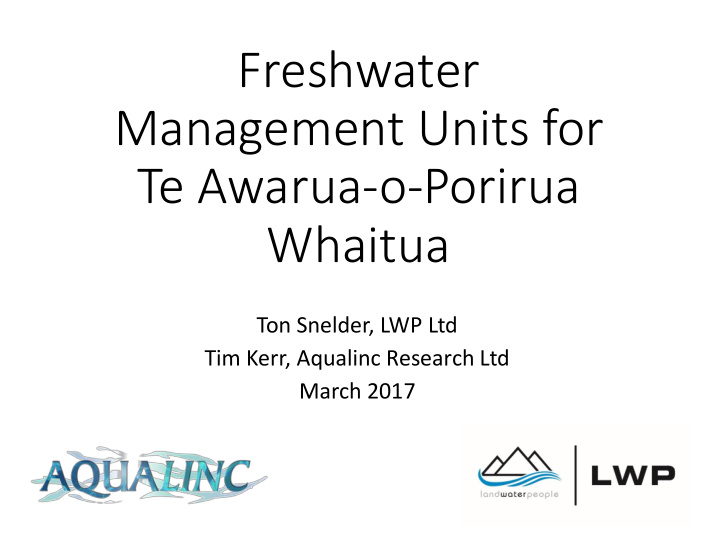



Freshwater Management Units for Te Awarua-o-Porirua Whaitua Ton Snelder, LWP Ltd Tim Kerr, Aqualinc Research Ltd March 2017
Outline 1. Brief recap on philosophy for FMUs 2. Initial recommended biophysical FMUs for Te Awarua-o-Porirua Whaitua 3. Modifications to the Urban management class.
1. Criteria for defining FMUs • Incorporate the water body and its catchment • Discriminate differences in values and “capacity for resource use” [ current state - water quality] • Basis for defining justifiable plan provisions (objectives and policies) • Practically monitored and administered • Provide plan clarity and certainty – boundaries • Easily altered and revised as part of plan development • Need a “Goldilocks” number, not too many, nor too few
The bio-physical classification approach • Assume water bodies with similar catchment characteristics: • have similar states (e.g. water quality) • have similar values (e.g. fishing, swimming, irrigation) and associated objectives • respond in similar ways to pressures/change/management • Provides a transparent and justifiable starting point for defining FMUs • Later on, can incorporate sites of special interest, social, cultural &/or economic considerations
Original management classes • Dominant land cover + catchment slope • 3 classes • Rural + Hill • Rural + Lowland • Urban • Plus coastal classes • Harbour • Taupo swamp • Open coast • Resulted in 5 classes
Recommended water quality FMUs • Assume management regimes are most restrictive; • Blue > Green > Red > Purple • Issue with designation of urban class
Reassessment of the urban land cover threshold • Many stream segments have > 15% urban • Originally classified rural • Committee uncomfortable with their assessment as rural • Choice of threshold • Attempted to use water quality data in justification
Can we justify an urban threshold? New E.coli data Previously used WQ data reapplied to test of discrimination
Management zones - 15% urban land cover threshold
FMUs based on 15% urban threshold
Conclusion • That an “objective” basis for choosing a criteria to define the Urban class did not emerge from our analysis • The choice will need to be based on informed judgement about stream character and values the Whaitua • There is a precedent in the use of 15% as a threshold in the widely used REC • The Whaitua Committee need to consider and ratify the classification, zone and FMU maps • In your experience, do they look right?
THANK YOU
Recommend
More recommend